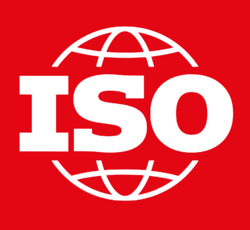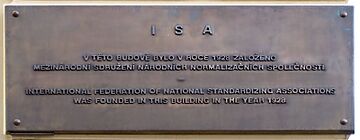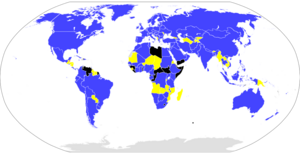International Organization for Standardization facts for kids
 |
|
| Abbreviation | ISO |
|---|---|
| Predecessor | International Federation of the National Standardizing Associations (ISA) |
| Formation | 23 February 1947 |
| Type | Non-governmental organization |
| Purpose | International standards development |
| Headquarters | Geneva, Switzerland |
|
Membership
|
170 members (39 correspondents and 4 subscribers) |
|
Official languages
|
|
|
President
|
Sung Hwan Cho |
| Remarks | UID: CHE-105.816.788 CH-ID: CH-660-3098013-3 |
The International Organization for Standardization, better known as ISO, is a worldwide group that creates rules, or standards, for millions of different things. It is an independent organization, meaning it is not controlled by any single government. Instead, it is made up of experts from the national standards organizations of its member countries.
ISO was created on February 23, 1947. Since then, it has published over 25,000 international standards. These standards cover almost everything you can think of, from technology and manufacturing to food safety and healthcare. The goal is to make sure products and services are safe, reliable, and of good quality.
The organization is based in Geneva, Switzerland. Its work is done in three official languages: English, French, and Russian.
Contents
What's in a Name?
You might think "ISO" is just an abbreviation for the organization's name. But it's a little more clever than that. In English, the name would be abbreviated as "IOS," but in French, it would be "OIN" (from Organisation internationale de normalisation).
To avoid confusion, the founders chose the short name ISO. This comes from the Greek word isos (ίσος), which means "equal." This way, no matter the country or language, the organization's name is always ISO. This name shows that the goal is to make things equal and consistent everywhere.
The name ISO and its logo are registered trademarks, so their use is limited.
History of ISO

The group we know as ISO started in 1926 as the International Federation of the National Standardizing Associations (ISA). The ISA mostly focused on standards for mechanical engineering.
The ISA had to stop its work in 1942 during World War II. After the war, a new group from the United Nations suggested forming a new global standards organization.
In October 1946, members from 25 countries met in London. They agreed to create the International Organization for Standardization. The new organization officially started its work on February 23, 1947.
How ISO is Organized
ISO is a voluntary group. Its members are the main standards authorities from different countries. They meet every year at a General Assembly to plan the organization's goals. A central office in Geneva helps coordinate everything.
A council of 20 members provides guidance and manages the budget. The real work of creating standards is done by over 800 technical committees and subcommittees. These groups are made up of experts from all over the world.
Working with Other Groups
ISO often works with other organizations. It has a special joint technical committee with the International Electrotechnical Commission (IEC). This committee, called JTC 1, was created in 1987. It develops standards for information technology (IT), like computers and the internet.
Who Can Be a Member?
As of 2022, ISO has 167 member countries. Each country is represented by only one organization. There are three types of membership:
- Member bodies: These are the main standards organizations in their countries. They are the only members with the right to vote on new standards.
- Correspondent members: These are countries that don't have their own standards organization. They are kept up-to-date on ISO's work but can't vote.
- Subscriber members: These are countries with smaller economies. They pay lower fees and can follow the development of standards.
How is ISO Funded?
ISO gets its money from a few different sources:
- Organizations that manage specific projects.
- Yearly fees from its member bodies. The amount each country pays depends on its economy.
- Selling copies of its standards.
What Does ISO Publish?
ISO's main products are its international standards. But it also creates other helpful documents like technical reports, specifications, and guides.
- International Standards: These are the most common type of document. They have names like ISO 9001:2015, where the number identifies the standard and the year shows when it was last updated.
- Technical Reports: These documents contain information that is different from a standard, like explanations or references.
- Technical Specifications: These are created when a topic is still being developed. They are like a first draft of a standard.
- Guides: These are "standards for making standards." They give rules to the technical committees on how to do their work.
Most ISO documents are protected by copyright and must be purchased. This helps fund the organization's work. However, some standards are made available for free.
How a Standard is Made
Creating an international standard is a long process with several steps. This ensures that the final standard is useful, fair, and agreed upon by experts worldwide.
- Proposal: Someone suggests an idea for a new standard.
- Preparation: A working group of experts is formed to write a first draft.
- Committee: The draft is shared with the committee members, who give feedback and suggest changes.
- Enquiry: The improved draft, now called a Draft International Standard (DIS), is shared with all ISO member countries. They have five months to vote and comment.
- Approval: If the draft gets enough positive votes, it becomes a Final Draft International Standard (FDIS). Members do one last vote to approve it.
- Publication: Once approved, the final document is published as an official International Standard (IS).
This process can sometimes be slow, especially for complex topics. There have been discussions about how to make it faster while still being fair. Sometimes, big companies try to influence the process, which can lead to disagreements among members.
Everyday Examples of ISO Standards
You might use ISO standards every day without even realizing it. The fact that so many standards are used everywhere has led to "ISO" being used to describe the product itself.
- ISO Images: When you download a large computer program, it might come as an ".iso" file. This file format follows the ISO 9660 standard for organizing files on a disc.
- Photo ISO: In photography, a camera's sensitivity to light is called its "ISO speed." This is based on standards like ISO 5800.
- ISOFIX: The standard system for safely attaching child car seats in vehicles is called ISOFIX.
- Shipping Containers: The large metal boxes you see on ships, trains, and trucks are a standard size. This is thanks to the ISO 668 standard, and they are often called "ISO containers."
- Countries in the International Organization for Standardization
- Ecma International
- European Committee for Standardization
- GOST
- IEEE Standards Association
- International Electrotechnical Commission
- International Telecommunication Union
- Internet Engineering Task Force
- Standardization
- Standards organization
See also
 In Spanish: Organización Internacional de Normalización para niños
In Spanish: Organización Internacional de Normalización para niños


